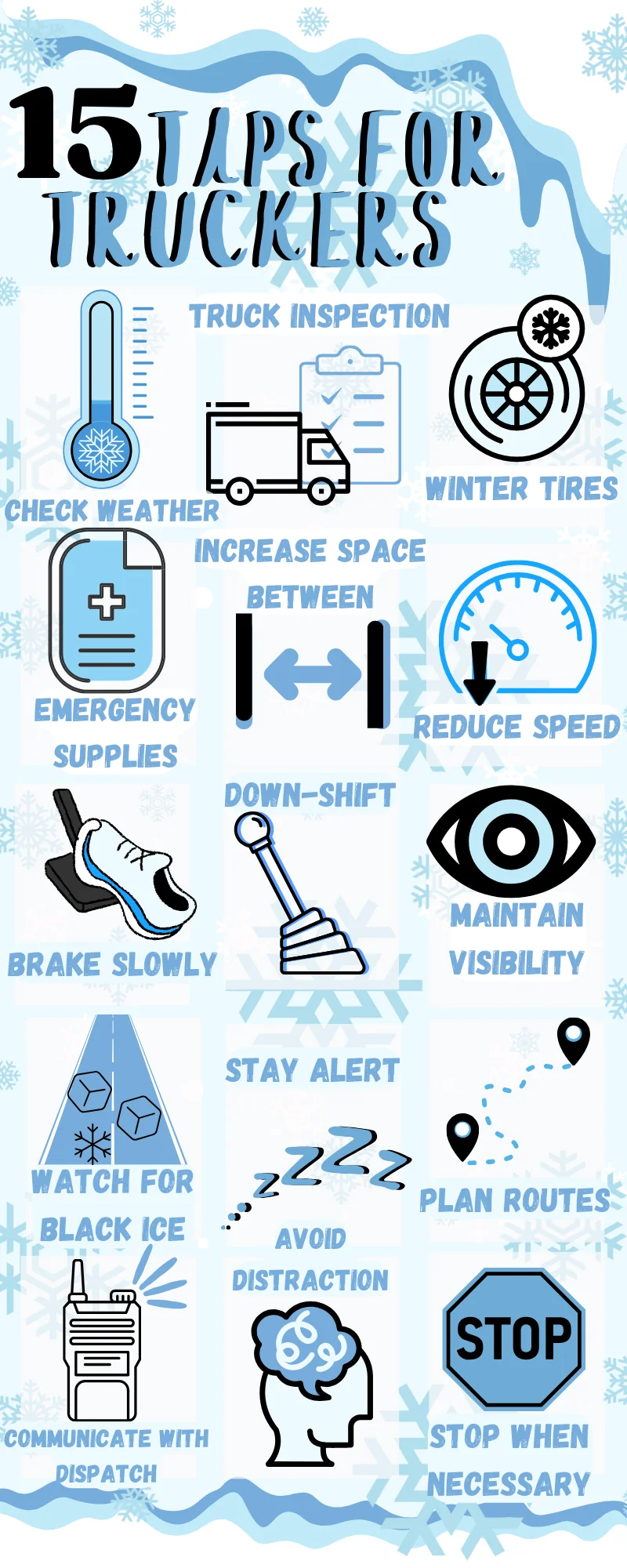
Winter Driving: 15 Tips for Truckers
Winter turns trucking into a challenging endeavor. In this exploration, we delve into the world of driving a semi-truck in winter conditions, where icy roads test drivers' skills and determination. Here you'll find facts and tips about driving through the winter-time.
Winter, with its transformative touch, blankets our surroundings in a picturesque wonderland. However, for freight truck drivers, it ushers in a formidable set of challenges. Navigating a freight truck through snow-covered landscapes demands not only skill and expertise but also a heightened awareness of the safety dangers that lurk beneath the frosty facade. Driving a freight truck in snowy conditions requires critical precautions that truck drivers must embrace to safeguard their well-being and the well-being of fellow travelers on the icy highways.
Driving in Snow
Amidst these winter nights, as the world is cloaked in darkness and cold, a silent hero emerges, ensuring that essential goods reach their destinations despite the chill and the snow. The freight industry, often overlooked, plays a crucial role during the winter season. In order to keep these essential workers safe during the busy season it is important to keep the following facts and tips in mind while navigating the countries busy and sometimes snowy. icy, and sleety roadways.
We provide competitive freight shipping prices and an all-inclusive, easy-to-use shipping experience for our customers. Exceeding our customers’ expectations results in thousands of satisfied customer reviews and repeat business. We believe in the power of our customer relationships. Check out FreightCenter reviews from real customers, and learn what they have to say about their freight shipping experience!
Awards and Endorsements
- 2021 Food Logistics’ Top Green Providers
- 2021 & 2018 Supply & Demand Chain Executives' Pros to Know: Matthew Brosious
- 2020 & 2019 Top Food Logistics’ 3PL & Cold Storage Provider Award
- 2020 & 2019 Business Observer’s Top 500 Companies on the Gulf Coast
- 2020 & 2017 SmartWay® Transport Partner
- 2020 & 2017 Food Logistics’ Champions: Rock Stars of the Supply Chain
- 2021 Food Logistics’ Top Green Providers
- 2020 Best of Palm Harbor Awards for Local Businesses
- 2017 Green Supply Chain Award from Supply & Demand Chain Executive
- 2017 Tampa Bay Business Journal Heroes at Work
- 2016, 2015, & 2012 Food Logistics Top 100 Software and Technology Providers
- 2013 Tampa Bay Business 100 by Tampa Bay Business Journal
- 2013 Top 100 Great Supply Chain Partners by SupplyChainBrain
- 2012 TIA Samaritan Award Honorable Mention
- 2012, 2011 & 2010 TBBJ Fast 50 Recipient
- 2013, 2011, & 2010 Diversity Business Top Businesses

15 Winter Safety Tips
- Check Weather and Road Conditions: Before you hit the road, check weather forecasts and road conditions along your route. Stay informed about any adverse weather warnings or closures.
- Inspect Your Truck: Conduct a thorough pre-trip inspection, paying special attention to tires, brakes, lights, and heating systems. Ensure all systems are in good working order to handle the cold weather.
- Equip Winter Tires or Chains: If you’re traveling through areas with heavy snowfall or icy conditions, equip your truck with winter tires or snow chains for improved traction.
- Carry Emergency Supplies: Pack an emergency kit that includes essentials like blankets, non-perishable food, water, a first aid kit, a flashlight, and extra clothing. These supplies can be a lifeline if you get stranded.
- Increase Following Distance: Maintain a generous following distance from vehicles in front of you. In slippery conditions, it takes longer to stop, and extra space allows for safer braking.
- Reduce Speed: Drive at a speed that suits the road conditions. Slowing down gives you more time to react to potential hazards and reduces the risk of skidding.
- Brake Gently: Avoid sudden or hard braking, which can lead to skidding. Apply the brakes gently and progressively to avoid losing control.
- Use Engine Compression: Downshift and use engine compression to help slow down instead of relying solely on your brakes. This can reduce wear on the brake system and enhance control.
- Maintain Visibility: Keep all windows, mirrors, and lights clean and free of snow and ice. Use defrosters and wipers to maintain good visibility, and ensure your headlights and taillights are visible to other drivers.
- Watch for Black Ice: Be vigilant for black ice, which is nearly invisible and extremely slippery. If you encounter it, do not make sudden movements or apply brakes abruptly.
- Stay Well-Rested: Fatigue can impair your ability to react quickly. Ensure you’re well-rested before embarking on a winter journey and take regular breaks to stay alert.
- Plan Your Route: Plan your route carefully, considering alternative routes in case of road closures or traffic delays. Inform someone of your route and expected arrival time.
- Communicate with Dispatch: Maintain open communication with your dispatch or company. They can provide updates on road conditions and offer support if needed.
- Avoid Distractions: Minimize distractions while driving. Focus on the road, and avoid using your phone or engaging in distracting activities.
- Know When to Stop: If conditions become too hazardous, do not hesitate to stop at a safe location and wait for conditions to improve. Safety should always be your top priority.
Winter Safety Tips for Snowy Roads
As winter blankets the world in pristine snow, it brings with it a mesmerizing transformation of landscapes into picturesque wonderlands. Yet, beneath this enchanting façade, the season also ushers in a host of challenges that pose a significant test for our roadways and those who navigate them.
Snow Accumulation: The most immediate and noticeable challenge of winter driving is the accumulation of snow on road surfaces. As the delicate snowflakes blanket the pavement, they dramatically alter the dynamics of driving. This accumulation creates a treacherous cocktail of reduced traction and diminished visibility, turning an ordinary road into an unpredictable terrain.
Driving on snow-covered roads demands a skillful touch, as even a gentle press on the accelerator can lead to wheels spinning futilely. Braking becomes an exercise in caution, as the vehicle’s stopping distance significantly increases. Maneuvering through the accumulating snow can feel like a delicate dance, with every move requiring precision and care.
Moreover, when winter storms unleash their full fury, the consequences can be severe. Severe snowfall accumulations can lead to road closures, trapping travelers and leaving them at the mercy of Mother Nature’s icy grip. In such situations, preparedness and patience become essential virtues for those braving the elements.
Ice Formation: Among the stealthiest and most treacherous adversaries of winter driving is black ice. This nearly invisible layer of ice forms surreptitiously on road surfaces when melted snow or ice refreezes. Its lack of visibility is a cruel deception, as it creates a deceptively smooth and glass-like surface that lures drivers into a false sense of security.
Black ice is notorious for catching drivers off-guard, leading to unexpected skids and loss of control. Steering on black ice feels like navigating on a frictionless surface, a harrowing experience that underscores the importance of caution and preparedness during winter travel.
Visibility Issues: Winter storms, often accompanied by heavy snowfall, freezing rain, and dense fog, conspire to significantly reduce visibility on the road. The world beyond the windshield becomes a hazy, indistinct blur, challenging drivers to discern road signs, other vehicles, and potential obstacles.
Navigating through such whiteout conditions becomes a test of one’s mettle, demanding heightened concentration and the ability to adapt to the ever-changing environment. Maintaining a safe following distance and reducing speed are critical strategies when visibility is compromised.
Cold Temperatures: The bone-chilling cold of winter brings additional challenges to the equation. Extreme cold can lead to frozen road surfaces, where even the most potent de-icing agents struggle to regain control. Salt, a common tool for melting ice, becomes less effective as temperatures plummet.
In addition to road conditions, the cold weather can wreak havoc on vehicles themselves. Batteries struggle to crank the engine, tires lose their elasticity and grip, and engine performance can falter. It’s a reminder that winter driving extends beyond just the road; it encompasses the entire vehicle and its ability to cope with the cold.
While winter bestows a certain charm upon the world, it also presents a formidable set of challenges for those who venture onto its snow-covered roadways. Snow accumulation, black ice, reduced visibility, and extreme cold are the four horsemen of winter driving challenges, each demanding respect, caution, and preparedness from those who dare to journey through the season’s icy embrace. Winter driving is not merely a task; it is a skill that requires mastery and an unwavering commitment to safety in the face of nature’s wintry whims.
Winter Safety Tips for Driving in Snow
- Prepare Your Vehicle:
- Install winter tires designed for enhanced traction on snow and ice.
- Regularly maintain your vehicle’s brakes, lights, and defrosters.
- Keep your gas tank at least half full to prevent fuel line freeze-ups.
- Carry an emergency kit including blankets, flashlights, extra clothing, and non-perishable snacks.
- Check Weather Forecasts: Before heading out, check weather forecasts and road conditions. If conditions are severe, consider postponing your trip or using public transportation.
- Drive Cautiously:
- Reduce your speed to match road conditions, and accelerate and decelerate gradually to prevent skidding.
- Maintain extra distance between your vehicle and the one ahead to accommodate longer stopping distances.
- Brake Carefully:
- Apply your brakes gently to avoid skidding. If you have antilock brakes (ABS), maintain firm, steady pressure on the brake pedal.
- Consider using engine braking by downshifting on slippery descents.
- Maintain Visibility:
- Keep your headlights on, even during the day, to improve visibility.
- Clear all windows and mirrors of snow and ice before driving.
- Stay Informed on Road Conditions:
- Listen to traffic updates and follow instructions from local authorities.
- Be aware of salt trucks and snowplows, and give them space to work.
- Use Safe Maneuvers:
- Avoid sudden movements or sharp turns when driving in snow.
- If you skid, steer in the direction you want to go, avoiding overcorrection.
By following these essential safety tips, you can confidently navigate snowy roads while reducing risks and ensuring your safety during the winter season. Remember, it’s better to arrive late than to risk your safety on snow-covered roads, so exercise caution and stay informed when venturing out in winter conditions.
Know about the potential risks to life and cargo as you venture out into the icy winter conditions so that you are prepared for whatever comes your way.
Increased Accident Risk: According to the Federal Motor Carrier Safety Administration (FMCSA), winter weather conditions contribute to approximately 24% of all weather-related crashes, with over 1,300 fatal accidents annually in the United States.
Winter weather can significantly increase commute times for truck drivers. On average, truckers experience a 15-25% increase in travel time during adverse winter conditions, leading to potential scheduling and delivery challenges.
According to the National Highway Traffic Safety Administration (NHTSA), winter months see a higher number of roadway fatalities compared to other seasons. In some regions, these fatalities can increase by as much as 50% during snowy or icy conditions.
The American Transportation Research Institute (ATRI) reports that winter weather accounts for 13% of all truck accidents. Additionally, during winter months, semi-trucks are more likely to experience mechanical breakdowns due to cold weather stress on equipment.
Winter storms lead to substantial delays in freight transportation. The American Transportation Research Institute estimates that, on average, winter weather causes a 12-17% increase in travel times, translating into higher costs and potential supply chain disruptions.
Cold weather negatively impacts fuel efficiency. Truck drivers may experience a 3-5% reduction in fuel economy during the winter due to factors such as engine idling to stay warm and reduced tire traction.
Winter road maintenance is a substantial expense. According to the American Association of State Highway and Transportation Officials (AASHTO), states collectively spend over $2.3 billion on winter maintenance annually, including snow removal and salting operations.
Insurance premiums for commercial trucks can increase during winter due to the elevated risk of accidents and cargo damage. The industry often experiences a spike in insurance claims during the colder months.


Why Choose to Ship with FreightCenter
- Convenient Shipping Quotes Anytime: At your convenience, you can obtain freight shipping quotes to destinations across the United States and Canada. We’re here whenever you need us.
- Unbeatable Discounts: Enjoy unbeatable discounts on a wide range of freight options, including LTL, truckload, rail, air, and more. We prioritize cost savings for your shipping needs.
- Effortless Automated Services: Our platform offers automated freight tracking, streamlined paperwork handling, and hassle-free invoice management. Say goodbye to paperwork headaches.
- Centralized Management: Manage all your quotes and shipments from a single, user-friendly interface. Simplify your logistics management process with FreightCenter.
- Decades of Expertise: With over 24 years of logistics experience, our team is dedicated to serving your needs. Benefit from our wealth of industry knowledge and experience.
Choosing Your Carrier
When it comes to selecting a carrier for your freight, you have the freedom to choose, and it’s a choice that can significantly impact your bottom line. By opting for a third-party logistics provider (3PL) like FreightCenter, you open doors to substantial cost savings without compromising on service quality.
The key to our success is healthy competition. At FreightCenter, we create an environment where top carriers compete for your business. The result? Competitive pricing and exceptional service that won’t break the bank.
Still skeptical? Try our instant freight quote tool to receive estimates from a variety of carriers, or speak with one of our experienced freight shipping experts by dialing 800.716.7608. When you entrust your shipping needs to FreightCenter, we handle all the necessary paperwork, scheduling, and logistics coordination, ensuring your cargo is shipped punctually and securely. It’s the smart choice for cost-effective, hassle-free shipping solutions.
Winter Driving FAQ
Q. What are the main challenges of winter driving?
Winter driving can be challenging due to reduced traction, limited visibility, snow and ice accumulation, and the potential for slippery road conditions.
Q. How can I prepare my vehicle for winter driving?
To prepare your vehicle for winter driving, consider the following steps: Equip winter tires for improved traction. Ensure brakes, lights, and defrosters are in good working condition. Maintain a minimum of half a tank of gas to prevent fuel line freeze-ups. Carry an emergency kit containing essentials like blankets, flashlights, and non-perishable snacks.
Q. What should I do if I encounter black ice or heavy snowfall while driving?
When encountering black ice or heavy snowfall during winter driving: Drive cautiously on black ice, avoiding sudden movements or sharp turns. In heavy snowfall, reduce speed, increase following distances, and keep headlights on for better visibility.
Q. What safety precautions should I take in extreme cold temperatures during winter driving?
Extreme cold can pose additional challenges during winter driving. To stay safe: Dress warmly with appropriate clothing. Be prepared for potential vehicle issues, such as battery problems or frozen road surfaces. Maintain a higher level of caution, as de-icing agents like salt may be less effective in extremely cold conditions.














